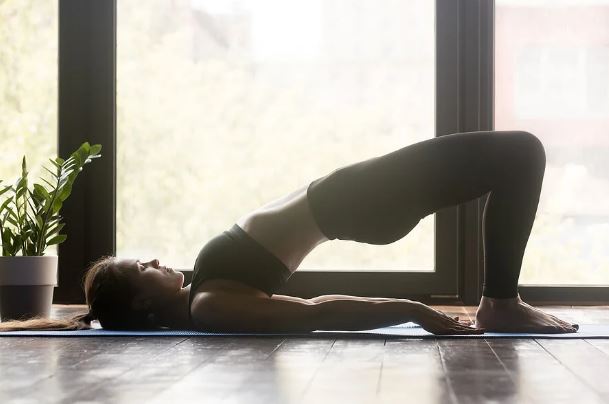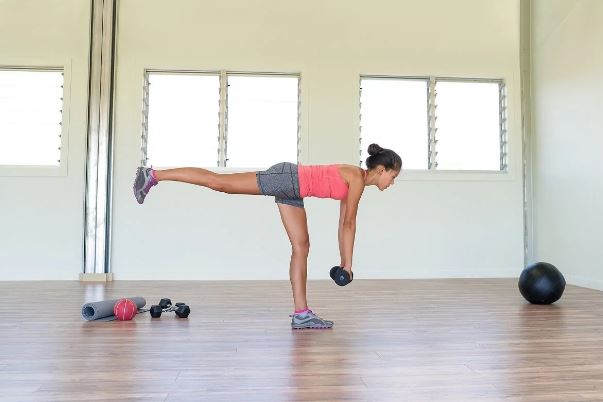Low back pain is one of the most common conditions between 35 and 55 years of age. There are many ways to counteract it, among which are glute exercises for lower back pain.

Low back pain, also known as lumbago, affects millions of people around the world. It is estimated that between 60% and 70% of the population will suffer it once in their life, with an increasing incidence in young groups. To prevent or treat it, we suggest some gluteal exercises that soothe lower back pain.
Far from working in isolation, your back muscles rely on many others to allow free mobility. Those involved are those in the core area, so your abs, pelvis, glutes, and deep muscles in your spine work together to support weight and tension.
When one of these is weakened, a load decompensation is generated that affects the lumbar area. Today we will focus on the one who is often omitted from therapy. With these glute exercises to relieve lower back pain you can take a first step towards your recovery.
7 exercises to relieve lower back pain
Before presenting you with a glute exercise routine for lower back pain, we must first advise you in which contexts you can apply it. If you are in the middle of the episode, especially if it is chronic (that is, it persists for more than 12 weeks), or you still suffer sequelae, the application of the exercises is contraindicated.
You should wait for the pain to go away so that you can develop the movements freely. If you exert tension in an area that is already under tension, the result will not be positive.
The exercises that we present shortly are useful to treat lumbago to the extent that they reduce your chances of suffering it in the future. All this through the strengthening of the buttocks, for which you can apply the following routine.
1. Buttock bridge
Also known as glute bridge, it is an intermediate level exercise that will help you work the muscles of the abdomen, hamstrings and lower back in parallel. You do not need any extra equipment, except for a mat for greater comfort.
1.Lie on the floor with your knees bent and your arms stretched out.
2.Your legs should be spread shoulder-width apart, slightly more apart from your torso than during the typical crunch position for abs.
3.Staring upward and tensing your core muscles, raise your hips to create a straight line from your knees to your chest.
4.Your shoulder blades should remain static, so you avoid putting weight on your neck. Do this ascent creating pressure against the ground, using your arms.
5.Hold this pyramidal position for 2-3 seconds and then return to the starting position.
Although it varies depending on your conditions and the existence of previous pain, we recommend doing 2-3 sets of 10-12 repetitions. If you can do more then increase the sets to 4-5. Remember to do the movements slowly and without overloading the lower back.

The classic gluteal bridge is an ideal exercise to start the routine that will improve lumbago.
2. One leg glute bridge
Variant of the previous exercise in which you raise the difficulty and more closely engage your gluteal and core muscles. It is suggested when you have already mastered the previous one.
1.Lie on the floor with your knees bent and your arms extended. You can point them in or out, depending on your balance or comfort.
2.Spread your feet to the natural width of your shoulders and avoid looking to the sides or down.
3.Start by bringing your right leg up to your chest and then raise your hips by pressing with the left leg that has remained on the ground.
4.Avoid pulling with your right knee to build momentum; should be developed only with the help of the muscles of your left flank, based on the supporting leg.
5.It also avoids that there is an imbalance or fall towards the right area. Hold the pressure for 2-3 seconds, lower your hips and repeat the movements until the set is complete.
6.Alternate legs to work the muscles on your opposite flank.
As in the previous case, you can start with 2-3 sets of 10-12 repetitions and gradually increase, depending on how you feel. There are many variants of this exercise, in which the free leg is stretched at different angles. These are for advanced athletes, as they demand a greater commitment from the core.
Read More:-Barium enema test: what is it and how is it performed
3. Backward lunges
One of the most complete gluteal exercises for lower back pain that, in general, can be practiced by anyone regardless of her physical condition. Engage hamstrings, calves, quads, abs, and glutes in one movement.
You do it in the following way:
1.Stand with your legs hip-width apart. Place your hands on the waist or together at the height of your chest to generate more weight when lowering.
2.Bring your right leg back until your knee touches the ground.
3.The quadriceps of this leg should make a perfect (or almost perfect) vertical line and should be supported on the back with the help of the toes.
4.Your other leg, the left, will remain immobile. You will not move it forward or backward.
5.Return to the starting position through a lunge and switch support legs to repeat the steps again.
While doing this exercise, you should keep your back straight, your shoulders dropped and relaxed, your gaze fixed on the front, and press on your abdomen to avoid loss of balance. You can start with 2-3 sets of 8-10 reps.
4. Squats
Although they are far from being a new exercise, you can not stop including squats in your routine to strengthen the lower back. It is a very easy option to do, you do not need equipment and it involves different muscles.
To avoid injuries, do them based on these indications:
1.Stand with your legs spread to the natural width of your shoulders.
2.Spread your feet out a little, so you get better balance and avoid execution errors.
3.Place your hands on your hips, together at the height of your chest or extended in front of you forming a parallel line with the ground.
4.With your back straight and your gaze straight ahead, lower yourself until your quads are parallel.
5.Do it without your knees going over the balls of your feet; something that you achieve more effectively if you lower your butt backwards.
Since its complexity is not that high, you can do 3-4 sets of 10-12 reps during your first session. Increase progressively based on how your muscles respond.
5. Fire hydrant
Also known as fire hydrant, it is one of the gluteal exercises for lower back pain most used in rehabilitation therapies. Do it by following these steps:
1.Lie face down on the floor with your hands and knees for support.
2.Keep all four limbs open to natural shoulder width as you face straight ahead.
3.Raise the right leg laterally as high as you can. Do this without losing knee flexion and without throwing your hips or mid-torso too much off balance.
4.Once you reach your height limit, wait a second before returning to the starting position.
5.Repeat the movement, always trying to achieve a 90 degree angle during the lift.
We suggest you do 2-4 sets of 10 reps. Remember to alternate legs to work the muscles on your other flank.
6. Ball hip thrust
We put aside the glute exercises for lower back pain that you can do without equipment. In this case you will need a fitness or Pilates ball and you will also focus your attention on relaxing and eliminating tension in the lower back.
Proceed as follows:
1.Lie down with the ball under your back. This should be at the level of your shoulder blades, so that part of your head rests on it.
2.Extend your legs and bend your knees until the calves are perfectly vertical to the ground. Keep your back straight and contract your core muscles to prevent your midsection from collapsing.
3.Make small swings with your hips up and down. Take a deep breath and avoid looking to the side.
Complete 12 swings up and down and then rest. We suggest doing 5 sets, although they can be more or less according to your physical condition.
7. Deadlift / hip hinge
We finish with an exercise with weight, so you can quickly strengthen the muscles near your lower back. For this we chose the hip hinge deadlift, a movement that you can do with dumbbells or with two objects that have the same weight.
1.Stand with your legs spread naturally shoulder width apart. Bring these forward so that the dumbbells or objects are just in front of your quads.
2.Without bending your legs, or failing that, bending them as little as possible, bend your upper body towards the ground and carry the additional weight down.
3.Hold this position for a second and then go back to where you started. Do the exercise in 2-3 sets of 8 repetitions.

Deadlift exercises are many and can be adapted to the capacity of each person. You must choose the number of kilograms well so as not to injure yourself.
Lifestyle and recommendations to relieve lower back pain
Exercising is just one of the things you should implement. Your lifestyle can encourage the appearance of chronic lumbar symptoms, so if you do not want to suffer from pain in the future, keep the following recommendations in mind:
Avoid standing or sitting for a long time.
Modify the repetitive actions you do at work or at home.
Maintain a weight according to your height and age.
Use conditioned chairs to protect your lower back.
Sleep with an orthopedic or specially designed mattress for back pain.
Take care of your posture when bearing weight from the ground. Bend your knees and lower yourself down to avoid strain and injury.
You should also avoid tobacco, as it decreases blood flow.
Keep in mind that as you age you naturally lose muscle mass. This increases the chances of low back pain and other back pain. The best prevention method is to take care of your posture, avoid carrying more weight than necessary, and try to maintain a healthy life in general.





